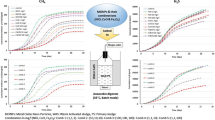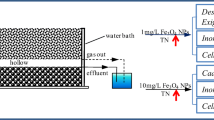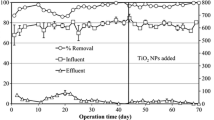Abstract
Fe2O3 nanoparticles have been reported to enhance the dechlorination performance of anaerobic systems, but the underlying mechanism has not been clarified. This study evaluated the technical feasibility, system stability, microbial biodiversity and the underlying mechanism involved in a Fe2O3 nanoparticle-coupled anaerobic system treating 4-chlorophenol (4-CP) wastewater. The results demonstrated that the 4-CP and total organic carbon (TOC) removal efficiencies in the Fe2O3-coupled up-flow anaerobic sludge blanket (UASB) were always higher than 97% and 90% during long-term operation, verifying the long-term stability of the Fe2O3-coupled UASB. The 4-CP and TOC removal efficiencies in the coupled UASB increased by 42.9±0.4% and 27.5±0.7% compared to the control UASB system. Adding Fe2O3 nanoparticles promoted the enrichment of species involved in dechlorination, fermentation, electron transfer and acetoclastic methanogenesis, and significantly enhanced the extracellular electron transfer ability, electron transport activity and conductivity of anaerobic sludge, leading to enhanced 4-CP biodegradation performance. A possible synergistic mechanism involved in enhanced anaerobic 4-CP biodegradation by Fe2O3 nanoparticles was proposed.

Similar content being viewed by others

References
Bandal H A, Jadhav A R, Chaugule A A, Chung W-J, Kim H (2016). Fe2O3 hollow nanorods/CNT composites as an efficient electro-catalyst for oxygen evolution reaction. Electrochimica Acta, 222: 1316–1325
Bao T, Damtie M M, Hosseinzadeh A, Frost R L, Yu Z M, Jin J, Wu K (2020). Catalytic degradation of P-chlorophenol by muscovite-supported nano zero valent iron composite: Synthesis, characterization, and mechanism studies. Applied Clay Science, 195: 105735
Chan L K, Weber T S, Morgan-Kiss R M, Hanson T E (2008). A genomic region required for phototrophic thiosulfate oxidation in the green sulfur bacterium Chlorobium tepidum (syn. Chlorobaculum tepidum). Microbiology (Reading, England), 154(Pt 3): 818–829
Chen D, Shen J, Jiang X, Su G, Han W, Sun X, Li J, Mu Y, Wang L (2019). Simultaneous debromination and mineralization of bromophenol in an up-flow electricity-stimulated anaerobic system. Water Research, 157: 8–18
Elsamadony M, Elreedy A, Mostafa A, Fujii M, Gescher J, Yekta S S, Schnürer A, Gaillard J F, Pant D (2021a). Perspectives on potential applications of nanometal derivatives in gaseous bioenergy pathways: Mechanisms, life cycle, and toxicity. ACS Sustainable Chemistry & Engineering, 9(29): 9563–9589
Elsamadony M, Mostafa A, Fujii M, Tawfik A, Pant D (2021b). Advances towards understanding long chain fatty acids-induced inhibition and overcoming strategies for efficient anaerobic digestion process. Water Research, 190: 116732
He C S, He P P, Yang H Y, Li L L, Lin Y, Mu Y, Yu H Q (2017a). Impact of zero-valent iron nanoparticles on the activity of anaerobic granular sludge: From macroscopic to microcosmic investigation. Water Research, 127: 32–40
He K, Yin Q D, Liu A K, Echigo S, Itoh S, Wu G X (2017b). Enhanced anaerobic degradation of amide pharmaceuticals by dosing ferroferric oxide or anthraquinone-2,6-disulfonate. Journal of Water Process Engineering, 18: 192–197
Jiang X B, Chen Y Z, Hou C, Liu X D, Ou C J, Han W Q, Sun X Y, Li J S, Wang L J, Shen J Y (2018). Promotion of para-chlorophenol reduction and extracellular electron transfer in an anaerobic system at the presence of iron-oxides. Frontiers in Microbiology, 9: 2052
Jing Y, Wan J, Angelidaki I, Zhang S, Luo G (2017). iTRAQ quantitative proteomic analysis reveals the pathways for methanation of propionate facilitated by magnetite. Water Research, 108: 212–221
Kato S, Hashimoto K, Watanabe K (2012). Methanogenesis facilitated by electric syntrophy via (semi)conductive iron-oxide minerals. Environmental Microbiology, 14(7): 1646–1654
Kong F, Wang A, Ren H Y (2014). Improved 4-chlorophenol dechlorination at biocathode in bioelectrochemical system using optimized modular cathode design with composite stainless steel and carbon-based materials. Bioresource Technology, 166: 252–258
Kwean O S, Cho S Y, Yang J W, Cho W, Park S, Lim Y, Shin M C, Kim H S, Park J, Kim H S (2018). 4-Chlorophenol biodegradation facilitator composed of recombinant multi-biocatalysts immobilized onto montmorillonite. Bioresource Technology, 259: 268–275
Lea-Smith D J, Bombelli P, Vasudevan R, Howe C J (2016). Photosynthetic, respiratory and extracellular electron transport pathways in cyanobacteria. Biochimica et Biophysica Acta, 1857(3): 247–255
Li L L, Tong Z H, Fang C Y, Chu J, Yu H Q (2015). Response of anaerobic granular sludge to single-wall carbon nanotube exposure. Water Research, 70: 1–8
Liang B, Kong D Y, Qi M Y, Yun H, Li Z L, Shi K, Chen E, Vangnai A S, Wang A J (2019). Anaerobic biodegradation of trimethoprim with sulfate as an electron acceptor. Frontiers of Environmental Science & Engineering, 13(6): 84
Liang J, Li W, Zhang H L, Jiang X B, Wang L J, Liu X D, Shen J Y (2018). Coaggregation mechanism of pyridine-degrading strains for the acceleration of the aerobic granulation process. Chemical Engineering Journal, 338: 176–183
Liu D, Lei L, Yang B, Yu Q, Li Z (2013). Direct electron transfer from electrode to electrochemically active bacteria in a bioelectrochemical dechlorination system. Bioresource Technology, 148: 9–14
Liu F, Rotaru A E, Shrestha P M, Malvankar N S, Nevin K P, Lovley D R (2015a). Magnetite compensates for the lack of a pilin-associated c-type cytochrome in extracellular electron exchange. Environmental Microbiology, 17(3): 648–655
Liu F H, Rotaru A E, Shrestha P M, Malvankar N S, Nevin K P, Lovley D R (2012a). Promoting direct interspecies electron transfer with activated carbon. Energy & Environmental Science, 5(10): 8982–8989
Liu X M, Sheng G P, Luo H W, Zhang F, Yuan S J, Xu J, Zeng R J, Wu J G, Yu H Q (2010). Contribution of extracellular polymeric substances (EPS) to the sludge aggregation. Environmental Science & Technology, 44(11): 4355–4360
Liu Y, Zhang Y, Ni B J (2015b). Zero valent iron simultaneously enhances methane production and sulfate reduction in anaerobic granular sludge reactors. Water Research, 75: 292–300
Liu Y W, Zhang Y B, Quan X, Li Y, Zhao Z Q, Meng X S, Chen S (2012b). Optimization of anaerobic acidogenesis by adding Fe powder to enhance anaerobic wastewater treatment. Chemical Engineering Journal, 192: 179–185
Lo K H, Lu C W, Lin W H, Chien C C, Chen S C, Kao C M (2020). Enhanced reductive dechlorination of trichloroethene with immobilized Clostridium butyricum in silica gel. Chemosphere, 238: 124596
Luo J, Feng L, Chen Y, Li X, Chen H, Xiao N, Wang D (2014). Stimulating short-chain fatty acids production from waste activated sludge by nano zero-valent iron. Journal of Biotechnology, 187: 98–105
Lynd L R, Weimer P J, van Zyl W H, Pretorius I S (2002). Microbial cellulose utilization: Fundamentals and biotechnology. Microbiology and Molecular Biology Reviews: MMBR, 66(3): 506–577
Ma D, Wang J, Chen T H, Shi C B, Peng S C, Yue Z B (2015). Iron-oxide-promoted anaerobic process of the aquatic plant of curly leaf pondweed. Energy & Fuels, 29(7): 4356–4360
Pan C, Giammar D (2020). Interplay of transport processes and interfacial chemistry affecting chromium reduction and reoxidation with iron and manganese. Frontiers of Environmental Science & Engineering, 14(5): 81
Rotaru A E, Shrestha P M, Liu F H, Shrestha M, Shrestha D, Embree M, Zengler K, Wardman C, Nevin K P, Lovley D R (2014a). A new model for electron flow during anaerobic digestion: Direct interspecies electron transfer to Methanosaeta for the reduction of carbon dioxide to methane. Energy & Environmental Science, 7(1): 408–415
Rotaru A E, Shrestha P M, Liu F, Markovaite B, Chen S, Nevin K P, Lovley D R (2014b). Direct interspecies electron transfer between Geobacter metallireducens and Methanosarcina barkeri. Applied and Environmental Microbiology, 80(15): 4599–4605
Shen L, Zhao Q C, Wu X E, Li X Z, Li Q B, Wang Y P (2016). Interspecies electron transfer in syntrophic methanogenic consortia: From cultures to bioreactors. Renewable & Sustainable Energy Reviews, 54: 1358–1367
Shi J, Han Y, Xu C, Han H (2019). Enhanced biodegradation of coal gasification wastewater with anaerobic biofilm on polyurethane (PU), powdered activated carbon (PAC), and biochar. Bioresource Technology, 289: 121487
Shrestha P M, Malvankar N S, Werner J J, Franks A E, Elena-Rotaru A, Shrestha M, Liu F, Nevin K P, Angenent L T, Lovley D R (2014). Correlation between microbial community and granule conductivity in anaerobic bioreactors for brewery wastewater treatment. Bioresource Technology, 174: 306–310
Siggins A, Enright A M, O’Flaherty V (2011). Temperature dependent (37–15°C) anaerobic digestion of a trichloroethylene-contaminated wastewater. Bioresource Technology, 102(17): 7645–7656
Tawfik A, Hassan G K, Awad H, Hassan M, Rojas P, Sanz J L, Elsamadony M, Pant D, Fujii M (2021). Strengthen “the sustainable farm” concept via efficacious conversion of farm wastes into methane. Bioresource Technology, 341(1): 125838
Viggi C C, Rossetti S, Fazi S, Paiano P, Majone M, Aulenta F (2014). Magnetite particles triggering a faster and more robust syntrophic pathway of methanogenic propionate degradation. Environmental Science & Technology, 48(13): 7536–7543
Wang D, Liu X, Zeng G, Zhao J, Liu Y, Wang Q, Chen F, Li X, Yang Q (2018). Understanding the impact of cationic polyacrylamide on anaerobic digestion of waste activated sludge. Water Research, 130: 281–290
Wang S, Chen C, Zhao S, He J (2019). Microbial synergistic interactions for reductive dechlorination of polychlorinated biphenyls. Science of the Total Environment, 666: 368–376
Wang Z, Gao M, Wang S, Xin Y, Ma D, She Z, Wang Z, Chang Q, Ren Y (2014). Effect of hexavalent chromium on extracellular polymeric substances of granular sludge from an aerobic granular sequencing batch reactor. Chemical Engineering Journal, 251: 165–174
Winkler M K H, Meunier C, Henriet O, Mahillon J, Suárez-Ojeda M E, Del Moro G, De Sanctis M, Di Iaconi C, Weissbrodt D G (2018). An integrative review of granular sludge for the biological removal of nutrients and recalcitrant organic matter from wastewater. Chemical Engineering Journal, 336: 489–502
Wu C Y, Zhuang L, Zhou S G, Li F B, Li X M (2010). Fe(III)-enhanced anaerobic transformation of 2,4-dichlorophenoxyacetic acid by an iron-reducing bacterium Comamonas koreensis CY01. FEMS Microbiology Ecology, 71(1): 106–113
Xi T H, Li X D, Zhang Q H, Liu N, Niu S, Dong Z J, Lyu C (2021). Enhanced catalytic oxidation of 2,4-dichlorophenol via singlet oxygen dominated peroxymonosulfate activation on CoOOH@-Bi2O3 composite. Frontiers of Environmental Science & Engineering, 15(4): 55
Xiao Y, Zhao F (2017). Electrochemical roles of extracellular polymeric substances in biofilms. Current Opinion in Electrochemistry, 4(1): 206–211
Xu L, Wang J (2012). Magnetic nanoscaled Fe3O4/CeO2 composite as an efficient Fenton-like heterogeneous catalyst for degradation of 4-chlorophenol. Environmental Science & Technology, 46(18): 10145–10153
Yan W, Shen N, Xiao Y, Chen Y, Sun F, Tyagi V K, Zhou Y (2017). The role of conductive materials in the start-up period of thermophilic anaerobic system. Bioresource Technology, 239: 336–344
Yang Y, Guo J, Hu Z (2013). Impact of nano zero valent iron (NZVI) on methanogenic activity and population dynamics in anaerobic digestion. Water Research, 47(17): 6790–6800
Yin Q D, Miao J, Li B, Wu G X (2017). Enhancing electron transfer by ferroferric oxide during the anaerobic treatment of synthetic waste-water with mixed organic carbon. International Biodeterioration & Biodegradation, 119: 104–110
Yin Q D, Yang S, Wang Z Z, Xing L Z, Wu G X (2018). Clarifying electron transfer and metagenomic analysis of microbial community in the methane production process with the addition of ferroferric oxide. Chemical Engineering Journal, 333: 216–225
Yoshida N, Yoshida Y, Handa Y, Kim H K, Ichihara S, Katayama A (2007). Polyphasic characterization of a PCP-to-phenol dechlorinating microbial community enriched from paddy soil. Science of the Total Environment, 381(1–3): 233–242
Zhang D J, Li W, Hou C, Shen J Y, Jiang X B, Sun X Y, Li J S, Han W Q, Wang L J, Liu X D (2017). Aerobic granulation accelerated by biochar for the treatment of refractory wastewater. Chemical Engineering Journal, 314: 88–97
Zhang F, Hou J, Miao L Z, Chen J, Xu Y, You G X, Liu S Q, Ma J J (2018). Chlorpyrifos and 3,5,6-trichloro-2-pyridinol degradation in zero valent iron coupled anaerobic system: Performances and mechanisms. Chemical Engineering Journal, 353: 254–263
Zhang J, Zhang Y, Quan X, Chen S (2013). Effects of ferric iron on the anaerobic treatment and microbial biodiversity in a coupled microbial electrolysis cell (MEC): Anaerobic reactor. Water Research, 47(15): 5719–5728
Zhao J, Li Y, Chen X, Li Y (2018). Effects of carbon sources on sludge performance and microbial community for 4-chlorophenol waste-water treatment in sequencing batch reactors. Bioresource Technology, 255: 22–28
Zhao J G, Chen X R, Wang L, Xu Y, Li J H, Li Y H (2017a). Effects of elevated 4-chlorophenol loads on components of polysaccharides and proteins and toxicity in an activated sludge process. Chemical Engineering Journal, 330: 236–244
Zhao J G, Chen X R, Zhao J, Lin F K, Bao Z, He Y X, Wang L, Shi Z D (2015). Toxicity in different molecular-weight fractions of sludge treating synthetic wastewater containing 4-chlorophenol. International Biodeterioration & Biodegradation, 104: 251–257
Zhao Z, Li Y, Quan X, Zhang Y (2017b). Towards engineering application: Potential mechanism for enhancing anaerobic digestion of complex organic waste with different types of conductive materials. Water Research, 115: 266–277
Zhao Z, Zhang Y, Quan X, Zhao H (2016a). Evaluation on direct interspecies electron transfer in anaerobic sludge digestion of microbial electrolysis cell. Bioresource Technology, 200: 235–244
Zhao Z, Zhang Y, Yu Q, Dang Y, Li Y, Quan X (2016b). Communities stimulated with ethanol to perform direct interspecies electron transfer for syntrophic metabolism of propionate and butyrate. Water Research, 102: 475–484
Acknowledgements
This research is financed by the Natural Science Foundation of Jiangsu Province (No. BK20170038) and National Natural Science Foundation of China (Nos. 51778294 and 51708295).
Author information
Authors and Affiliations
Corresponding authors
Additional information
Highlights
• 4-chlorophenol biodegradation could be enhanced in Fe2O3 coupled anaerobic system.
• Metabolic activity and electron transport could be improved by Fe2O3 nanoparticles.
• Functional microbial communities could be enriched in coupled anaerobic system.
• Possible synergistic mechanism involved in enhanced dechlorination was proposed.
Supporting information
11783_2022_1519_MOESM1_ESM.pdf
Enhanced 4-chlorophenol biodegradation by integrating Fe2O3 nanoparticles into an anaerobic reactor: long-term performance and underlying mechanism
Rights and permissions
About this article
Cite this article
Hou, C., Jiang, X., Li, N. et al. Enhanced 4-chlorophenol biodegradation by integrating Fe2O3 nanoparticles into an anaerobic reactor: Long-term performance and underlying mechanism. Front. Environ. Sci. Eng. 16, 98 (2022). https://doi.org/10.1007/s11783-022-1519-6
Received:
Revised:
Accepted:
Published:
DOI: https://doi.org/10.1007/s11783-022-1519-6



